 In the summer when I was a kid, our family would head to the Jersey "Shore" for a week to enjoy the sand and surf of the Atlantic. One of my favorite things back then was finding sea glass--shards of broken bottles and such that had been tossed into the ocean as garbage. Time and waves and grinding sand would smooth the pieces into colored gems in all colors of the rainbow. They were smooth, yet sandy to the touch. The shapes often looked like faces or an animal shape, and if I found a cobalt blue one it would become my new lucky piece to be carried daily in my dungaree pocket. In Italy, you can also find pebble beaches. For instance, near the famous Murano glassworks in the Venice lagoon, there are places that were used to dispose of broken glass for hundreds of years. Divers bring up buckets of the stuff and sell the gems to jewelry designers. You can walk the shores around Murano, or even go as far as the Lido beach at low tide and see what colorful treasures you can find. You can also try your luck in Scalea, a pebbled beach in Calabria or in Positano on the Amalfi Coast. Some sea glass hunters had luck on the coastline of Capri, the rugged beaches of Cinque Terre and even the Gargano Peninsula north of Bari. And here's another idea... If you are ever in Vietri sul Mare near Salerno on the Amalfi Coast, try beach-combing in the area. Vietri has been a center of ceramic production for generations. The broken pieces were tossed into the sea, which has created soft-edged shards of colorful pottery to be found on the beaches. If you're lucky and find a lot, perhaps you can use them to create your own ceramics treasure. --Jerry Finzi If you enjoyed this post, please SHARE it and LIKE it. Grazie!
12 Comments
Lucas has entered Middle School and the sixth grade this year. He's so excited about his new locker, his great teachers, new friends and the possibilities ahead of him. Today he came home especially excited because he can be a real salesman (he loves sales and marketing), and he thought perhaps you might be interested in what he has to offer, with any sales benefiting his school.
If you are interested in helping his school, please click on the photo below... the link will take you to the Great American School Store site where you can purchase magazines, tote bags, books, videos, jewelry and much more. But you will also be helping Lucas win a VIP Experience at his school where top "salesmen" will be entertained by acts that appeared on TV's America's Got Talent program. If he does even better with his sales, he could win a ride in a Limosine Party Bus with his friends, complete with music, snacks, flat screen TVs, some swag and a free lunch. Lucas says to everyone, "mille grazie" for considering his offer... Off the Tourist Path: Castello Incantato - the Enchanted Castle and Stone Heads of a Madman9/24/2015  Filippo Bentivegna Filippo Bentivegna Deep in the southern part of the island of Sicily, near the town of Sciacca is a sad, yet wonderful story of a man, his madness and the amazing fruit born of his troubled mind. With no artistic training, this disturbed shell of a man carved thousands of stone sculptures at Castello Incanto, the "Enchanted Castle" at his farm. Filippo Bentivegna_ was born in Sciacca on May 3, 1888--his father was a fisherman, his mother a housewife. In 1913 he emigrated to the U.S., following two older brothers and a sister, as many southern Italians were doing in the early 20th century. In America he suffered a serious blow on the head, which brought on amnesia and the inability to earn a living. Some claimed that he had been assaulted and sustained brain damage while others said a woman broke his heart which caused him to injure himself. He was subsequently considered unproductive and declared unfit for work and was repatriated to Italy in 1919. Things went even worse for him after his return to Italy. It was determined that the time he spent in America was essentially an act of desertion from participation in WW I. He discovered that while he was gone, a judgement was handed down for desertion with a three year prison term--this was his new burden. But before he could be put in jail, he needed to undergo a psychiatric evaluation--which he failed. Not considered a threat to the public, he wasn't jailed, but some would say was thrown into a much darker place--his clouded and troubled mind.  With the little money he had, he bought a small plot of land on the outskirts of Sciacca. Living alone, he built a small hut and began to develop the rocky land... he began to carve heads from the outcroppings. In his mind's eye, he was carving the likenesses of people he had met in real life, both in American and Italy. He sculpted for over 35 years until there were more than 1000 heads. His work was never recognized while he was alive, and his eccentric behavior earned him the title of village madman. The villagers mocked him as Teste Filippo (Phillip's Head) or Filippo il Pazzo (Phillip the Crazy) for his bizarre attitude--he demanded he be addressed as Excellency because he was the king of his little domain. After his death in 1967 at age 79, his family turned the site into a tourist attraction and garden. People visit the site to admire his heads, the gardens and a series of frescoes Bentivegna painted inside his little house. The place was dubbed the Enchanted Castle. It is an amazing place to see these primitive works of art and try to understand the visions in the mind that created them. Visit the Castello Incantato on Facebook. --Jerry Finzi If you enjoyed this post, please share the link on your favorite social media site. Grazie. It was refreshing to see Pope France being driven around in exactly the same car as we drove in Tuscany... the Fiat 500L. He must be enjoying the higher viewing angle from the elevated rear seat (Fiat calls this "theater seating"), just like Lucas enjoyed his higher view of the world. But then again, the Pope doesn't need to be "elevated".... he already is. I wonder if his has that little glove box drink chiller? They are even the same color... although his is kept a bit cleaner than we kept ours (caused by the dusty clay roads in Tuscany).
When I was a boy, we used to take a ride every week or so down to Willow Avenue in Hoboken, New Jersey to visit my maternal Grandmother at her apartment in a brick row house. The visits were boring for the most part for a little kid who would rather be playing "down The Cliffs" overlooking the Hudson River, the Erie-Lackawanna railroad yards and the Manhattan skyline--my childhood playground. "Gramma" was a bit abrupt in those days and her apartment was very formal... doilies on the backs of chairs, under vases, under candy dishes... basically, doilies everywhere. The candies in the bowls were almost always those hard-as-rock candy coated almonds or sour candies. I wasn't a fan of either. If I was was offered what Gramma considered a "cookie", it was typically one of those dry, hard tarelle which didn't dunk well in milk and threatened to break my teeth. Even if she had the type with icing on top, it was still a very dry mouthful. For lunch it was usually some pasta with my Gramma's sauce--overloaded with onions and peppers. Not what I was used to (when was eleven, I first tried to blame my appendix pains on her sauce). For entertainment, there was no TV... only a radio tuned permanently to the Italian radio station. There was no such thing as kid-friendly in those days, and most Italian nonni back then didn't keep a stock of snacks, drinks and toys at their houses to entertain the bambini during their occasional obligatory visit, as millennial grandmothers do nowadays. But there were two things I loved doing when I went to visit her. My sister and I used to head out across the street to a row house that had a little shop window a few steps down the basement stairs--the Nut Man. He would slide open a heavy wooden "window" and sell us a bag of his salted pumpkin seeds for about 10 cents. They were so thick with salt that my lips would go numb. I loved the salt more than the seeds inside. Then my sister and I would then walk down to the end of the block where there was my all time favorite thing to do... a visit to Mimi.  Freeze frame from an old film of the Italy Pavilion at the 1939 Worlds Fair Freeze frame from an old film of the Italy Pavilion at the 1939 Worlds Fair In the vacant lot at the end of my Gramma's street was a huge white statue of a beautiful, half-naked lady laying on her back. Her profile reminded me of the Statue of Liberty with a strong nose. Her one arm was laid at her side while the other was held up toward the sky as she lay there. She was beautiful. She looked hot to my 7 year old eyes, but as a young artist, I secretly wished I had sculpted her, like Michelangelo might have. She was also the only truly large statue I had seen up to that point--a real treat for a budding artist--my Mom always said that I could draw before I could talk. I remember doing my first really good portrait of a Chinese boy in my class when I was six. I shocked my mother once, asking for her to "pose in the nude" for me--her foot. (She got a big laugh out of that joke, but my pencil drawing came out fantastic). Staring at this huge white statue intrigued and inspired me... "Maybe I could carve a statue like that some day!" The Legend... Now, I'm not sure who told us the story of "Mimi", as she was called, but there was a spooky, scary legend that I was convinced must be true. We were told that every night after midnight, Mimi would stand up and walk slowly around the streets of Hoboken, and by daybreak she would come back to her vacant lot behind the chain link fence to sleep. But there was more... We were also told that if you stare at Mimi very closely... focused on one thing (her eyes, her hand, her foot) that you might see her move. It might not be much, but just enough movement to convince us that the legend was true. Well, as I sucked the salt from those pumpkin seeds, I'd stare and stare and try not to blink as I watched the corner of Mimi's mouth or the tip of a finger... and I'm not sure if it really happened or not, or was the effect of all that salt on a seven year old's blood pressure causing my eyeballs to twitch, but I swear I saw her move more than a few times. I was sure the Legend of Mimi was true. Now fast forward almost sixty years... A while back I was scanning, editing and enhancing some old family photos when I came upon this one of my Dad standing in front of the Italian Pavilion at the 1939 Worlds Fair. As I blew up the image in Photoshop to retouch it, I suddenly had a familiar feeling... It's Mimi! It had to be. She has the same strong nose, the same lack of proper attire and had one arm raised. She seems about the right size, too.... from 12-15 feet tall or thereabouts. I've since done a lot of research trying to find out what happened to the sculptures after the 1939 Worlds Fair in New York.--to no avail. There are some references, which I'm sure are true, about these statues being mostly made of plaster--they weren't made to last. Thinking back, I'm sure Mimi was plaster, not stone. I'm sure much of the fair grounds were simply demolished and would up in land fills. But I'm also convinced that some things must have been taken by demolition crews, members of social clubs of various nationalities, and other connected people. Tearing down such a beautiful Worlds Fair must have had the garbage-pickers and hoarders coming out of the woodwork. Plus, Hoboken always had a very large contingent of Italian immigrants living there. Many were active in Italian societies and organizations. Many also had connections to back home in Italia (Hoboken and Molfetta Italy, where my father was born, both host the Festa di Martiri). Others were perhaps "connected" in other nefarious ways to the Mob--and along with it--to the construction, demolition and garbage haulers of the day. It would be a simple task to truck such a statue back to Hoboken in hopes to use it for something... someday. Who knows, perhaps to decorate a daughter's backyard wedding! I've done some research and never found a direct connection to my "Mimi" and the "Roma" statue (as it was named for the Italy Pavilion), but in my mind's eye, it's her. I can't tell you the feeling I got when I first saw that photo of my Dad after not really paying attention to it in so many years. And I've got to tell you... Mimi did influence me in my art. After always being known as an artist all through my childhood, I eventually left high school early and got a job as an apprentice metal sculptor for a studio that designed churches all over the world. After that, I eventually found my way into commercial advertising photography, a craft where my art was ever-present. When visiting Italy my eyes were always drawn to sculptures, especially the ones with strong, proud, Italian noses--just like Mimi had. Perhaps someday I'll find someone who remembers Mimi and how she got to lie on her back in a Hoboken vacant lot. I wonder what ever happened to her... Darn.... now I'm getting a craving for some salted pumpkin seeds.... --Jerry Finzi If you enjoyed this post, please tell your friends about us... grazie. The contents of this article are copyrighted material. Copyright 2015, Jerry Finzi - All rights reserved
 There are many places in Italy where the sights you see with your own two eyes seem unbelievable... you can hardly trust what you are seeing. One of them is in Tropea, with it's Citadel on the Rock, which can easily be considered one of the most beautiful sights anywhere in the world. The coastline and the villages here are well worth exploring. Tropea is a seaside resort with impressive scenery in the region of Calabria, in the south of Italy in the Vibo Velentia province. When viewed on a map of Italy, Vibo Valentia looks like a little frog sitting on top of the Boot's instep. Calabria itself can be considered the foot of Italy. The mountains here are nearly impossible to cultivate but there is a gorgeous coastline with villages perched atop rugged high cliffs. No part of the region is more than 30 miles from the coast--one on the Tyrrhenian Sea, the other on the Ionian Sea. Tropea is perched on a cliff above the Tyrrhenian Sea.  Calabria has often been considered poor by most Italians but in fact is very rich in both beauty and has a varied and interesting history. This stretch of coastline on the Tyrrhenian Sea is called the Costa degli Dei (Coast of the Gods). The Ancient Greeks originally named this area, Entoria Tellus (Land of Wine). Being Part of Magna Graecia, the area is rich in Greek legends and mythology. Tropea's name comes from the Greek name Tropheum, referring to it being the trophy city of Hercules after he and Ulysses saved the town from two giants. It has become one of the finest summer holiday destinations--for Italians. Foreign Voyagers hardly know about the place. Tropea's historic centre is perched high above the sea on top of dramatic cliffs. It would make a great hub for a longer stay in Southern Italy to explore Calabria, Sicily and perhaps even the Salento. The local rail line and ferries afford lots of options for travel, cutting down the need to drive. You won't find much English spoken here, but you will find some German vacationers and lots of Italians, especially during Ferragosto, enjoying their month long vacation at the seaside. In May, June and September, Tropea is cheaper and less crowded with weather still warm and sunny. Anytime of day you will see visitors and locals alike taking a passeggiata down Corso Vittorio Emanuele, to shop, get a snack or meal, sit and people watch and catch the views of the sea at the Corso's end leaning on the railing right at the edge of the cliff. This view rivals the views from Sorrento with its views of Mount Vesuvius... from Tropea you can even catch a glimpse of the active Stromboli volcanic island! Tropea has a laid back, rustic, timeless charm that is missing in Northern towns. Of course, the best thing Tropea offers besides its white beaches is its citadel on the rock. On the rock outcrop jutting into the sea opposite the historic center is Santa Maria dell'Isola, an active monastery with its gardens. Side trips can easily be taken to Pizzo Calabro and Capo Vaticano, the two main towns in Vibo Valentia. In Pizzo you will find yet another village on cliffs over the sea, but you should visit its Church of Piedigrotta, a grotto chapel cared our of stone with amazing sculptures. You will find an amazing peaceful feeling in this cave with a lagoon nearby to refresh yourself in. Capo Vaticano has the most rugged cliffs imaginable with the whitest beaches tucked in between. Snorkeling is heavenly here, with waters so clear it's like diving in air. You can also take a ferry over to the village of Stromboli, on the volcanic island of the same name. It's most recent major eruption was in April of 2009. When you walk the streets of the white washed houses in Stromboli village, you will feel like you're in Greece. All in all, you'll find Tropea and the Coast of the Gods to be a great alternate to Cinque Terra, the Amalfi Coast or the Italian Riviera. Depending on the time of year you visit, you might have the place all to yourself--well, nearly so anyway. The beaches cannot be beat anywhere in Italy. The climate is wonderful. The food is amazing... and remember, you won't run into throngs of other tourists there. Just you and Italians.
Buon viaggio. --Jerry Finzi If you enjoyed this post, please send your friends on a Voyage with us. Grazie! I love smokey flavors. Smoked cheeses are the best. There is a brand of applewood smoked mozzarella that I typically have in my cheese draw for having with apple or pear slices. This gave me an idea... one day after having my BBQ Spice-Rubbed chicken breasts on the grill for Labor Day, I was looking for something to do with the one chicken breast leftover--it was a fat one. (Split chicken breasts come packaged four halves to a package, and we are a family of three so there's always one left over). I doctored up this quick recipe so Lisa would have a nice meal when she got home from the office (thank God she work's from home most days).
I put on a pot to boil water for cavatappi--my favorite pasta shape for cheese casseroles since its spiral shape holds cheese sauces so wall. I then shredded the chicken off the breastbones and added it to a saucepan with about 2 cups of my standard crushed tomato sauce that I usually have handy in the fridge. I added 3 or four good dashes of Liquid Smoke to enhance the sauce a bit, along with about 1/2 teaspoon of red pepper flakes. I wanted a little bit of heat. I then added a teaspoon of smoked paprika and set the sauce on a low back burner. Finally, I used the 1/2 side of my box grater to grate about 1-1/4 cups of the smoked mozzarella set it aside. The mis en place was completed... When the pasta was done I drained it in the large colander that I inherited from my Mom. I like to go a bit beyond al dente unless the sauce I'm using is very wet so the pasta doesn't dry out too much when baking. The pasta went into our larger sized Emile Henry lasagna pan. I then took the sauce-chicken mixture and poured it over the pasta and gently tossed until it was evenly distributed. To top it off I spread the shredded cheese over the top. I covered with foil (shiny side down) and then baked it for 35 minutes in a 425 degree, pre-heated oven. (In my old oven, I used to use 375 degrees, so check yours before committing this recipe to a full 35 minutes. ) I let it rest for 5 minutes before serving it to Lucas and Lisa with a tossed salad with some of my late season heirloom tomatoes in it. Smokey and cheesy. I still could taste the BBQ spices I used on the chicken rub. The dash of Liquid Smoke worked well too, bringing the sauce up a notch. Smokey... What more can you ask for? Buon Appetito! --Jerry Finzi If you enjoyed this recipe, please post a link to it on one of your favorite recipes sites. Grazie! 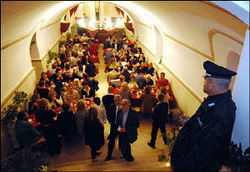 Don't even think about stealing the cutlery... Don't even think about stealing the cutlery... It starts many months before. You're "booked" by the Italian Ministry of Justice on Rome. Heaven help you if your two-month long, criminal background check finds something dark in your history. On the date of your "incarceration" you are walked through the cold steel bars of Volterra's Fortezza--a high security prison for prisoners serving sentences longer than 7 years. The guards will inspect multiple forms of your I.D., you turn over any electronic devices and are scanned in the metal detector. Nothing than can be used as a weapon is allowed! Then they lead you into a large, cool, dungeon-like room with vaulted ceilings-where you are seated and given plastic cutlery. Buon appetito! You have just gotten a table at the most exclusive--and unusual--restaurants in Tuscany, and perhaps the world. The Fortezza Medicea is the name of a restaurant begun in 2007 in Volterra, Italy. It is housed in what the people of Volterra simply call La Fortezza (the Fortress), a Renaissance defensive castle built 1474 that is used today as a high security prison. The oddity here is that prisoners are the ones who cook and serve your dinners. That's right, now you know why you're given plastic utensils to enjoy your gourmet meal. (And perhaps so you won't do anyone harm if the dinner is not up to your standards).  It was a dark and gloomy night--for dinner... at Volterra's Fortezza It was a dark and gloomy night--for dinner... at Volterra's Fortezza In 2006, the prison's administration began operating a restaurant within the prison, using inmates as staff, as a rehabilitation scheme. Prisoners who are incarcerated for crimes involving drugs or violent crime are now learning culinary arts that will give them a new lease on life--and new job opportunities--after they are finished serving their sentences. The project attracts both gourmands and press from around the globe. The restaurant is always booked weeks, if not months, in advance. Diners are also entertained with music provided by Bruno, a pianist with a life sentence for murder. The clientele eat inside a de-consecrated chapel set behind the 60 ft-high walls, watch towers, searchlights and security cameras. There are also meals served outside (in the exercise yard, perhaps?) The meals are reasonably priced at €25, which includes a glass of wine with each course.  From the prisoners' production of Alice in Wonderland From the prisoners' production of Alice in Wonderland So, if you want a truly unique dining experience, contact the Ministry of Justice in Rome and see if you can be booked... er, fingerprinted... uh, I mean get a table. Oh, and don't forget to ask how to get tickets for La Fortezza's theater to see a play while you're there. That's right, they also have a theater group. --Jerry Finzi If you enjoyed this post, please tell your friends about us. Ciao! Click the photo to Travel Back in Time to the 1950s and visit old Italy....
(a great photo exhibit courtesy BuzzFeed) "Making love and pizza are very much alike. When they are good, they are very, very good. When they are bad... they are still pretty good."
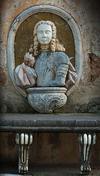 If you are ever in Palermo, you might want to take a ride out about 7 miles to the village of Bagheria, where you will find a Villa full on monsters--Villa Palagonia. This architectural gem, while rough at the edges, is full of eccentricity, oddities and hideous and grotesque sculptures that adorn the garden walls. In fact, this is a perfect choice for the modern Grand Voyage of Italy simply because it was also a popular stop for Voyagers taking their Grand Tour of Europe during the 18th and in the 19th centuries. 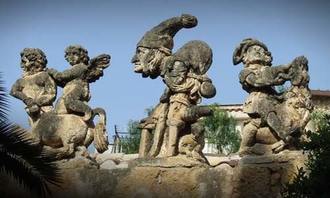 Built in 1715,Villa Palagonia became one of the most loved examples of the Sicilian Baroque style. However, it wasn't until a bit later that the villa became haunted by its monsters. The mentally unbalanced Prince of Palagonia, in 1749, ordered the gargoyles to be added atop the garden walls. Hunchbacks, soldiers doing battle (raping and pillaging), dragons, and various freaks in both human and animal form peer down at Voyagers here. One legend claims that most horrible faces resemble the many lovers of the prince’s wandering wife.  On the interior you will find a Hall of Mirrors (the ballroom) with many different kinds of birds and portraits of the Lords that the Prince associated with (er... the Lords, not the birds... although he was a bit flighty). The Villa has been privately owned by the same family from 1885 til the present day, and is partially open to the public. It has also be used in various movies over the years. Personally, I could easily picture a version of Beauty and the Beast here... this Villa is well suited to La Bete and La Belle... or perhaps Dracula would feel right at home here... --Jerry Finzi
If you enjoyed this post, please come back and visit again and again.... and tell your friends about us. Ciao! |
Categories
All
Archive
June 2024
|






















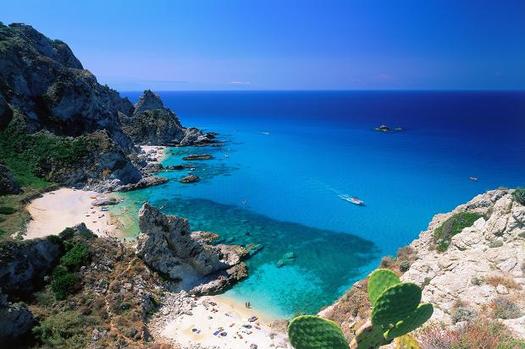

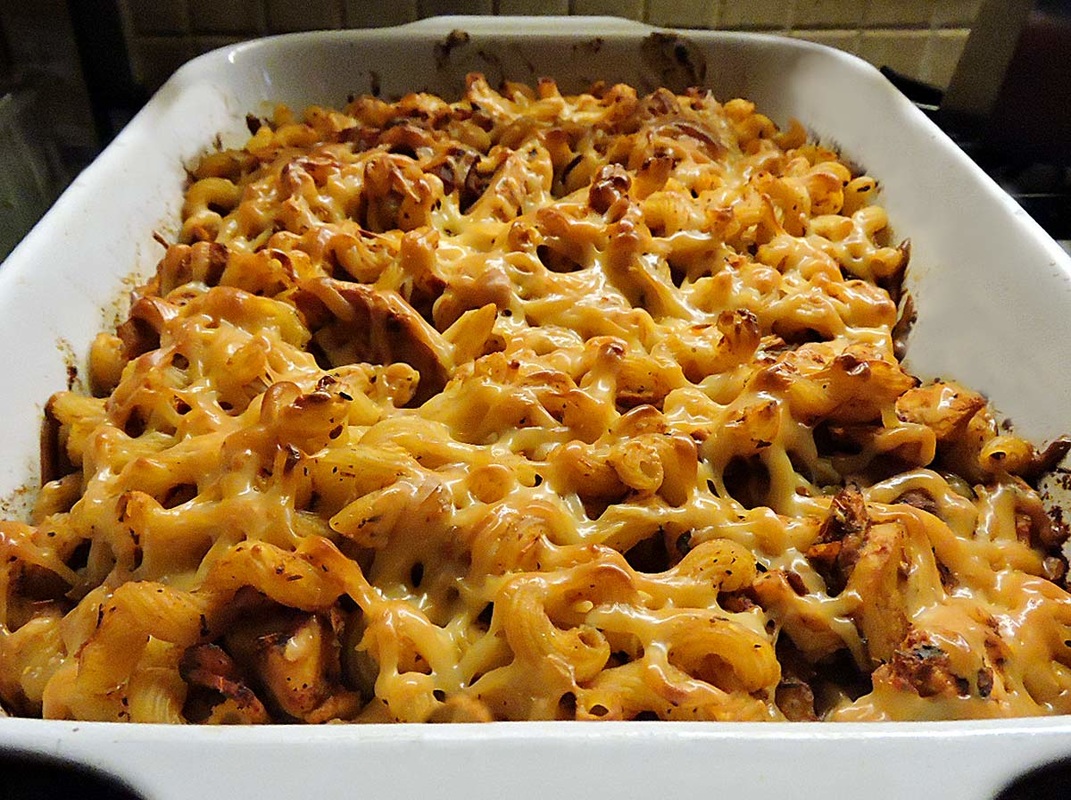











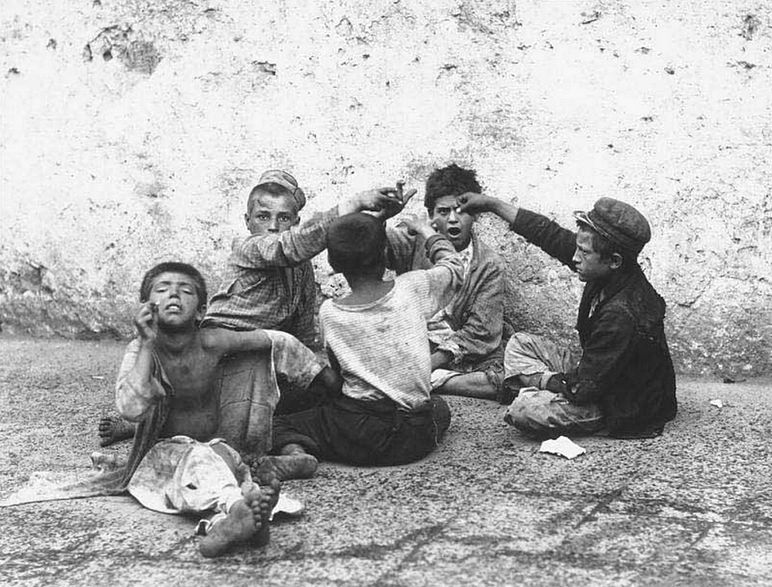
 RSS Feed
RSS Feed
